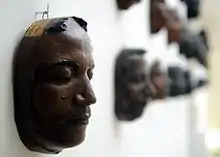Lidio Cipriani
Lidio Cipriani (17 March 1892 – 8 October 1962) was an anthropologist, university teacher and explorer from Florence.
Lidio Cipriani | |
|---|---|
 Facial plaster casts made by Lidio Cipriani (1927–1930). The original white plaster casts were then painted according to the color of the skin of the subject, using a color scale. | |
| Born | 17 March 1892 |
| Died | 8 October 1962 (aged 70) |
| Occupation(s) | Anthropologist, university teacher and explorer |
| Board member of | Museo nazionale di antropologia ed etnologia di Firenze |
| Awards |
|
| Academic background | |
| Alma mater | University of Florence |
| Academic work | |
| Discipline | Anthropologist, ethnologist |
| Sub-discipline | Physical anthropologist |
| School or tradition | Anthropometric school |
| Institutions | University of Florence |
| Notable works | The Andaman Islanders |
Education and academia
Cipriani first trained and worked as an elementary school teacher like his father. He then volunteered for the military and served in World War I. As of 1920 Cipriani studied Natural sciences and graduated in 1923, became docent of Anthropology at the University of Florence and Director of the Istituto e Museo Nazionale di Antropologia in the same university.[1] In 1924 Cipriani was awarded the International Broca Prize of Paris for Anthropology.[2] He distinguished himself by a long period of exploration and field work in several continents and among a large number of tribes and population of Africa, Southwest Asia and India.
Research
As an exponent of the anthropometric school, Cipriani was particularly interested in systematic measurements (cranial, but also of hands, feet, and all other kinds of body parts), and he was also fond of making plaster facial moulds made from life, for which he procured models among the populations he encountered.[3]
Cipriani's three journeys in Africa were documented by a large number of photographs and the chronicle was reported in his book In Africa dal Capo al Cairo (‘In Africa from the Cape to Cairo’) (1932): over 600 pages of anthropological, zoological, botanical and geological information.
His Indian work started in the South, in collaboration with the late Prof. Anantha K. Iyer and his work on the physical anthropology of the Toda (Arch. per l'Antrop. e la Etnol. LXVII, 1937 XV) and of the Coorg, Kuruba, Ierava etc. (Idem, LXV, 1935) throws new light on these populations.[4] Later, as a Foreign Fellow of the Anthropological Survey of India he collaborated with the late Dr. B. S. Guha in his work on the Onge of Little Andaman Island.[5] Cipriani died in his native Florence at the age of seventy on the 8 October 1962. A committed fascist, Cipriani was one of the authors of the Manifesto of Race, published on 14 July 1938 in Il Giornale d'Italia.[1] He began working at the Racial Office and contributing to Telesio Interlandi's journal La difesa della razza almost from its inception.[6]
Works
- Cipriani, Lidio (1932). In Africa dal Capo al Cairo. Florence: R. Bemporad & figlio.
- Cipriani, Lidio (1953). "Report on a Survey of the Little Andaman during 1951-53". Bulletin of the Department of Anthropology. 2 (1): 61–82.
- The Andaman Islanders. By Lidio Cipriani. Edited and translated by D. Taylor Cox, assisted by Linda Cole. New York: Frederick A. Praeger. 1966.
References
- Arnd Schneider (2020). Margareta von Oswald; Jonas Tinius (eds.). "Art-Anthropology Interventions in the Italian Post-Colony: The Scattered Colonial Body Project". Across Anthropology: Troubling Colonial Legacies, Museums, and the Curatorial. Leuven University Press: 222–241. ISBN 9789462702189.
- L. Girard (1924). "Rapport sur l'attribution du Prix Broca, en 1922 et 1924". Bulletins et Mémoires de la Société d'Anthropologie de Paris. 5 (5–4–6): 93–94.
- Loredana Polezzi (2007). Loredana Polezzi; Charlotte Ross (eds.). "White, Male, and Italian?: Performing Masculinity in Italian Travel Writing about Africa". In Corpore: Bodies in Post-unification Italy. Madison: Fairleigh Dickinson University Press: 44. ISBN 9780838641644.
- On Cipriani's collaboration with Ananthakrishna Iyer, see: Bala Ratnam (1963). L. K. Bala Ratnam (ed.). "A Name to Remember: Ananthakrishna Blazes a Trail". Anthropology on the March: Recent Studies of Indian Beliefs, Attitudes and Social Institutions. Book Centre: 22–46–53.
- Sita Venkateswar (2004). Development and Ethnocide: Colonial Practices in the Andaman Islands. IWGIA. p. 127. ISBN 9788791563041.
- Elisabetta Cassina Wolff (2013). Anton Weiss-Wendt; Rory Yeomans (eds.). "Biological Racism and Antisemitism as Intellectual Constructions in Italian Fascism: The Case of Telesio Interlandi and La difesa della razza". Racial Science in Hitler's New Europe, 1938–1945. University of Nebraska Press. ISBN 978-1-4962-1132-3.
External links
- Surdich, Francesco (1981). "CIPRIANI, Lidio". Dizionario Biografico degli Italiani, Volume 25: Chinzer–Cirni (in Italian). Rome: Istituto dell'Enciclopedia Italiana. ISBN 978-8-81200032-6.